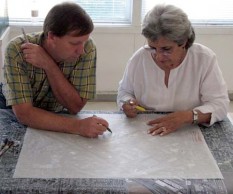Pedestrian traffic drives economic development in urban centers, but over the last half-century, rural communities have become more and more car dependent. Those same communities now face aging populations, declining local infrastructure, and limited access to economic opportunities.
In October 2007, Opticos completed its work on a downtown revitalization strategy for the historic agricultural community of Kingsburg, located 15 miles south of Fresno in California’s San Joaquin Valley—an area comprised of dispersed agricultural communities of immigrants and farmworkers. Kingsburg traces its heritage back to Swedish immigrants and has maintained and built upon its Swedish history, but has recently suffered from economic and physical decline. The city hoped to preserve its Swedish heritage, while also promoting a pedestrian-oriented, walkable community for residents and visitors.
 The Kingsburg project explored urban design solutions to encourage the downtown’s revitalization and maintain its centrality and significance within a growing metropolitan area. Opticos utilized a community-driven design process that culminated in a five-day community charrette, facilitated by the Local Government Commission and Walkable Communities, Inc.
The Kingsburg project explored urban design solutions to encourage the downtown’s revitalization and maintain its centrality and significance within a growing metropolitan area. Opticos utilized a community-driven design process that culminated in a five-day community charrette, facilitated by the Local Government Commission and Walkable Communities, Inc.
The resulting Revitalization Plan included new mixed-use development along major corridors, the creative re-use of the city’s historic structures including an existing downtown elementary school, a safe, well-connected street network for bicycles and pedestrians, and recommendations for long-term growth. Draper Street serves as the community’s Main Street and is the location of many popular restaurants, shops, and festivals. The design team recommended the expansion of pedestrian amenities to accommodate outdoor seating and promote pedestrian activity (shown in sketch above).
As a result of the city’s plan, the Kingsburg City Council conceptually approved a new paseo—Spanish for a public walk or boulevard—for an alley located between a café and a local boutique. The paseo would reclaim lost space, to become an area where downtown visitors could relax under ivy-covered archways. “Thanks in large part to [Opticos’s] efforts, Kingsburg is moving decisively in the direction of pedestrian- and bicycle-friendly, mixed-density, mixed-use development,” said Terry Schmal, Kingsburg’s Planning & Development Director.
Additionally, in the process of creating the plan, many issues with the city’s regulatory framework were revealed, which led to a 2010 rewrite of the city’s Form-Based Code to further protect Kingsburg’s Swedish character.
Click here to learn more Opticos’s work in small towns and rural communities.
Like this article? How about these: